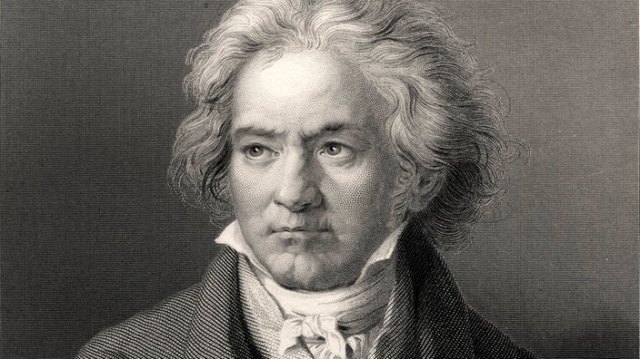
Beethoven’s Concertos
By John Clubbe
Beethoven is almost as well known for his concertos as for his symphonies. During his 20s and 30s each kind of composition ran parallel to the other. To make his way in the intensely competitive music world of Vienna during the 1790s he had to dazzle at the piano. He first composed for this purpose piano trios. Only towards the end of the decade did he attempt concertos and symphonies, forms of music that required larger forces. It took time for Beethoven to master the complexities demanded by both kinds of works.
Beethoven in 1784, at age thirteen, while still living in his hometown of Bonn had begun a piano concerto, but only the soloist’s part and bits of the orchestration survive. What remains of this concerto manifests his evolving conception of heroism, his awareness of the legend of Prometheus, the mythical Greek hero who defied the gods and whom Zeus punished by chaining him to a peak in the Caucasus. The Prometheus myth, in its various mutations, would inspire Beethoven all his life.
A living Prometheus soon appeared on the scene. After 1796 Beethoven followed with interest and admiration the stunning rise to power of Napoleon Bonaparte. His spectacular defeats of Austrian armies in Lombardy in 1796-97 had established his heroic credentials. Napoleon soon incarnated the Prometheus myth for Beethoven. That myth would influence several of his piano concertos.
Pianos evolved rapidly during the composer’s lifetime. As the eighteenth century yielded to the nineteenth, piano construction underwent a full-scale revolution. Makers rivaled each other in the size, structure, and number of octaves of their pianos. Music composed for the stronger pianos grew by leaps and bounds. At the fore was a martial vocabulary in music. Beethoven, who envisioned himself as a new Prometheus, felt that only now did he have an instrument that enabled him to play to greater advantage such dynamic new works as his piano concertos. The piano was thus poised to become one of the great implementers of German Romanticism. It became Beethoven’s battlefield, as later it would become Franz Liszt’s.
Beethoven premiered his first Piano Concerto, opus 15, at his Akademie, or benefit concert, of 1800. Putting on a concert in Vienna was no easy matter. Keep in mind as you listen to Beethoven’s concertos that in Vienna in his lifetime there were no regular concert seasons and no halls specifically designed for concertos and symphonies. Most concerts took place in theaters, which were available only when no play was being performed that evening. At the Akademie of 1800 he wished to demonstrate to a larger public his gifts as a soloist and composer. The work played was actually his second piano concerto. Far superior to the first (opus 19), it anticipates the essentially romantic, stormy, and fearlessly original Beethoven of later years. Concertos no less than symphonies were another way he could impress listeners.
This Akademie concert included three pieces by Mozart and three by Haydn. Only after these were played did the receptive audience hear Beethoven’s own music. You can draw your own conclusions. One might be that Beethoven wished to stress that he had inherited much from Vienna’s two great masters, Mozart, who had died in 1791, and Haydn, who was now nearing the close of a glorious career. The concert concluded with Beethoven’s First Symphony. Though now the least performed of the symphonies, it’s a fine, steady work. While it anticipates the mature composer, it does not overwhelm. At the end of this concert, Beethoven astonished the audience by improvising on the piano. He clearly wanted those present to know that a new man had appeared on the scene. He wished to leave no doubt who that man was.
Although Beethoven would write only five piano concertos, we should not forget that he wrote two other concertos as well: a deeply reflective Violin Concerto in 1806 and an exuberant Triple Concerto for violin, cello, and piano in 1807. The number of his completed concertos thus reaches seven. Both the Triple Concerto and the Violin Concerto are masterpieces, indicating Beethoven’s gift for composing other kinds of concertos.
Concertos and symphonies developed in counterpoint to each other, at least in Beethoven’s mind. He may even have preferred concertos, for then he could perform at the piano. He earned much of his income from his prominence as a piano teacher as well as a composer. The concertos became increasingly symphonic in their proportions and dramatic impact. In some ways the two forms merge, with the concertos taking on extended orchestral openings. In general, this leads to much more consequential orchestral writing.
The Third Concerto, begun in 1800 and completed three years later, was first performed in 1806, a year after the Eroica symphony. It far outstripped anything of its kind written before. Beethoven declared of his new concerto that it “will be the best of the three,” and he was right. With it his dramatic gift came into its own.
At this time, concert pianists played with the written score before them. For the first performance of his Third Concerto, Beethoven had not had time to write out the piano part. There was nothing on the page except what looked like, at least to the baffled individual who turned the pages, “Egyptian hieroglyphics.” That hapless individual was astounded, indeed terrified, for he had nothing to guide him until Beethoven, smiling, nodded, indicating he wished a page turned. No need to write out what he had in his head!
Only with the Third Symphony, completed in 1804 and known as the Eroica, or Heroic, did Beethoven fully earn his place among the music immortals. The Eroica premiered in June 1805. Both it and his Third Concerto are breakthrough works. They manifest giant leaps forward in skill, imagination, and competence. Carl Czerny, Beethoven’s protégé, heard him play his Third Piano Concerto in 1803, and described the nimbus of sound in the second movement as the augury of a “holy, distant and heavenly harmony.” The music sweeps us along, one dynamic passage leads to the next, even more dynamic. Listeners are on tenterhooks, at times feeling like they’re on a musical rollercoaster. Both works would achieve great fame, though not immediately.
Incidentally, it’s unwise to try to relate Beethoven’s music too closely to his life. Beethoven was temperamental, often ill, and beginning in 1796 increasingly deaf. Connections between his life and music there no doubt are, but with his magician’s wand he largely manages to detach the music he was writing from whatever personal difficulties he was undergoing at the time. We should also remember that Beethoven was not Viennese. He was a Rhinelander, born in Bonn, and as a youth he had responded positively to the French revolution. He moved to Vienna when he was twenty-one for the musical opportunities it offered. On the whole, he did not respond to the conservative Viennese, nor they to him, and his revolutionary ideas–and music–left him in constant conflict with his contemporaries.
The Fourth Concerto formed part of another of Beethoven’s benefit concerts, or Akademien. This one, played on December 22, 1808, took place in an unheated auditorium on a very cold night in Vienna. The program, lasting about four hours and including the Fifth and Sixth symphonies as well as several other works, was far too long. Beethoven’s other concertos had begun with the orchestra, with the piano only entering after an orchestral prelude. Starting the Fourth with the piano playing softly was a new approach. It sets up a dialogue between the soloist and orchestra leading to the epic confrontation in the second movement. This, in turn, leads to a further dialogue between the two in the third. Unfortunately, the premier, with Beethoven at the piano, did not go well, and the freezing audience responded tepidly.
The earliest sketches for the Fifth Concerto date from February 1809. The manuscript bears the words, in French, “Chant de triomphe pour le combat! “Attaque! “Victoire!”(Song of triumph for the battle! Attack! Victory!). Hapsburg Austria had again renewed its more than decade-long conflict with Napoleonic France. In Vienna Beethoven kept up his personal campaign both of rivalry with and emulation of Napoleon. By April, after Austria had declared war but several weeks before the French army arrived and occupied Vienna, he had largely completed his new, very grand concerto, a work bristling with military energy. He wrote it in his favorite key of E flat Major, thus giving it the same majestic tonality as the Eroica symphony. Whereas Napoleon looms over the Eroica, Beethoven, now at the helm, master of the piano, controls at least the solo part of the Fifth Concerto. “Österreich lohne Napoleon” he commented on the manuscript, “May Austria make Napoleon pay.”
By a strange irony this composition has become known in English-speaking countries as the “Emperor” concerto. Although the exact source of its nickname remains unknown, it first appeared in 1830s Britain and continues to be used reflexively today there and in America, though not in German-speaking lands. In this work the piano is pitted in a mighty duel against the full power of the orchestra, the soloist disputing the field against what appear to be Napoleonic cannon. So, by a supreme irony, the concerto’s sobriquet appears to derive from a French “Emperor.” But is Napoleon implied by that designation? To compound the confusion many LP jackets and CD jewel box cases housing the “Emperor” concerto sport a portrait of Napoleon, as do those for the Eroica. Ultimately its hero, however, the “Emperor” whom the concerto crowns, is Beethoven himself.
After the December 1808 Akademie Beethoven rarely played in public. He wrote piano music until the early 1820s, but the Fifth was his last concerto. He had written his concertos in order to play them. They were his calling cards, so to speak, to tell audiences what he was capable of doing. But his increasing deafness made playing difficult and with results uncertain. As the years went by, he heard less and less of the sounds he created. He had taken his time publishing his concertos, for as long as they remained unpublished only he could play them. But as his hearing faded his playing became increasingly ragged. So in mid-career he stopped writing concertos.
Beethoven therefore did not play the Fifth concerto before the Viennese public. Instead, the work received its premiere two years later, on November 28, 1811, at Leipzig’s Gewandhaus, with Carl Czerny as the soloist. The audience responded to it with enthusiasm. When Czerny introduced the concerto to Vienna in February 1812, it was met with indifference. That should not surprise us. Lack of understanding and appreciation on the part of the insouciant, waltz-infatuated Viennese was the fate of most of Beethoven’s path breaking major works. Compositions radiating Promethean power and new musical forms troubled his audiences. Although the concertos made their way but slowly in the musical consciousness of contemporaries, today they are pillars of the classical music repertory. The opportunity to hear all five of them over two evenings is one to be cherished.
Santa Fe Pro Musica will devote two full programs to Beethoven’s five piano concertos. Concerto Nos. 2, 3 and 4 will be performed on April 29 and 30 in the 2016-17 season. Concerto Nos. 1 and 5 will be performed on November 4 and 5, 2017 in the 2017-18 season.
John Clubbe is completing a study entitled Beethoven. The Relentless Revolutionary (W. W. Norton).





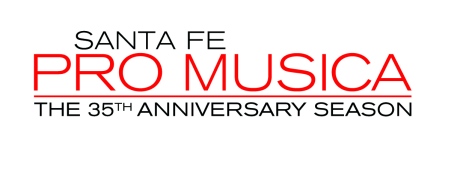 Santa Fe Pro Musica invites you to discover and celebrate their 35th Season. Join us for a magnificent season that is sure to transform and transport you. From Joshua Roman to Ida Kavafian to Benjamin Beilman to Anne-Marie McDermott, this year’s internationally-acclaimed guest artists join the Santa Fe Pro Musica Orchestra under the leadership of Thomas O’Connor in programs that juxtapose old and new masterpieces.
Santa Fe Pro Musica invites you to discover and celebrate their 35th Season. Join us for a magnificent season that is sure to transform and transport you. From Joshua Roman to Ida Kavafian to Benjamin Beilman to Anne-Marie McDermott, this year’s internationally-acclaimed guest artists join the Santa Fe Pro Musica Orchestra under the leadership of Thomas O’Connor in programs that juxtapose old and new masterpieces.
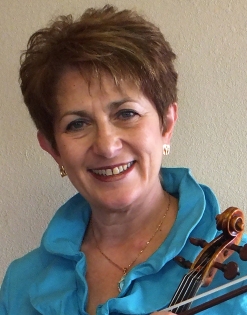 Santa Fe Pro Musica Orchestra
Santa Fe Pro Musica Orchestra

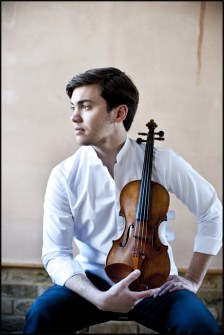






 for the relationship between art and politics.” Nicolas Slonimsky (1993) paints a more vivid portrait of the composer: “He is a granitically overpowering piano technician, capable of depositing huge boulders of sonoristic material across the keyboard without actually wrecking the instrument.”
for the relationship between art and politics.” Nicolas Slonimsky (1993) paints a more vivid portrait of the composer: “He is a granitically overpowering piano technician, capable of depositing huge boulders of sonoristic material across the keyboard without actually wrecking the instrument.” playwright Clifford Odets in 1939 and premiered in Buenos Aires in 1941. Not a populist work like his Appalachian Spring, the Piano Sonata instead represents Copland’s more “profound and personal thought” (Anne Shreffler). The outer sections of the first movement feature dense sonorous chordal writing. Contrasting with this is a quick middle section that indulges in inventive rhythmic play. The second movement explores fast rhythms in irregular, rapidly changing meters. Although the movement is not overtly jazz, Copland acknowledges, “I never would have thought of those rhythms if I had not been familiar with jazz.” The work ends with an extended, slow-moving passage of wide leaps marked “elegiac,” utilizing materials with the contours and moods of American folk ballads. Copland writes that he did not want to end with “the usual flash of virtuosic passages; instead, it is grandiose and massive.”
playwright Clifford Odets in 1939 and premiered in Buenos Aires in 1941. Not a populist work like his Appalachian Spring, the Piano Sonata instead represents Copland’s more “profound and personal thought” (Anne Shreffler). The outer sections of the first movement feature dense sonorous chordal writing. Contrasting with this is a quick middle section that indulges in inventive rhythmic play. The second movement explores fast rhythms in irregular, rapidly changing meters. Although the movement is not overtly jazz, Copland acknowledges, “I never would have thought of those rhythms if I had not been familiar with jazz.” The work ends with an extended, slow-moving passage of wide leaps marked “elegiac,” utilizing materials with the contours and moods of American folk ballads. Copland writes that he did not want to end with “the usual flash of virtuosic passages; instead, it is grandiose and massive.”
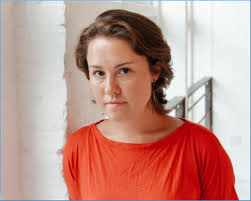 performs with the American Contemporary Music Ensemble (ACME). She has also performed with the Trinity Wall Street Choir, the Mark Morris Dance Group, and has appeared incognito as a backup singer and violinist on Saturday Night Live with Paul McCartney, on the Dave Letterman Show with The National (American indie rock band), on the Tonight Show with The Roots (American hip hop/neo soul band). Shaw has been a Rice University Goliard Fellow (busking and fiddling in Sweden) and a Yale Baroque Ensemble Fellow. In addition to maintaining a busy freelance career as a violinist and singer, she has received commissions to write music for the Carmel Bach Festival, the Cincinnati Symphony, the Guggenheim Museum, the Baltimore Symphony, and others. She is currently a doctoral candidate in composition at Princeton University.
performs with the American Contemporary Music Ensemble (ACME). She has also performed with the Trinity Wall Street Choir, the Mark Morris Dance Group, and has appeared incognito as a backup singer and violinist on Saturday Night Live with Paul McCartney, on the Dave Letterman Show with The National (American indie rock band), on the Tonight Show with The Roots (American hip hop/neo soul band). Shaw has been a Rice University Goliard Fellow (busking and fiddling in Sweden) and a Yale Baroque Ensemble Fellow. In addition to maintaining a busy freelance career as a violinist and singer, she has received commissions to write music for the Carmel Bach Festival, the Cincinnati Symphony, the Guggenheim Museum, the Baltimore Symphony, and others. She is currently a doctoral candidate in composition at Princeton University.

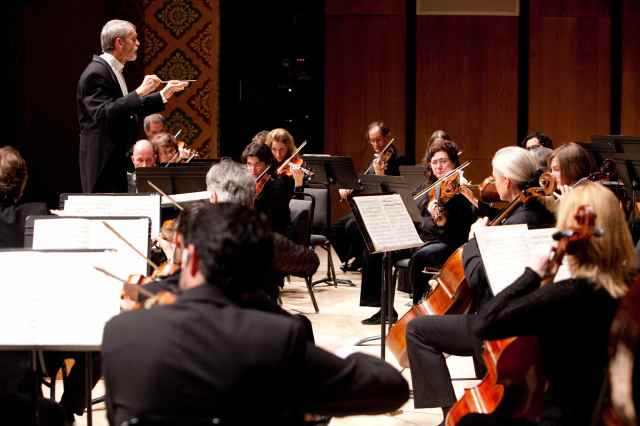 Santa Fe Pro Musica, founded in 1980, is a non-profit performing arts organization dedicated to inspiring and educating audiences of all ages through the performance of great music. Pro Musica performs a varied repertoire, covering four centuries of music on modern and baroque instruments, including works for chamber orchestra, small ensemble and large-scale works for orchestra and chorus. In 2008, Pro Musica’s recording of Gustav Mahler’s Das Lied von der Erde (chamber arrangement by Schoenberg) was nominated for a GRAMMY® award in the classical category of Best Classical Album/Small Ensemble. In August of 2012, Santa Fe Pro Musica Recordings produced a CD of Conrad Tao, pianist, performing Mozart Piano Concertos No. 17 and No. 25 and in 2013 produced a CD of music by Britten and Vaughan Williams. In addition to gaining national recognition over its 33 years for its artistry in performance, Santa Fe Pro Musica offers some of the most distinguished educational opportunities in northern New Mexico, reaching thousands of students every year with a Youth Concert series, a team-building, ensemble-training program, and a master class series featuring student ensembles working with world-class musicians.
Santa Fe Pro Musica, founded in 1980, is a non-profit performing arts organization dedicated to inspiring and educating audiences of all ages through the performance of great music. Pro Musica performs a varied repertoire, covering four centuries of music on modern and baroque instruments, including works for chamber orchestra, small ensemble and large-scale works for orchestra and chorus. In 2008, Pro Musica’s recording of Gustav Mahler’s Das Lied von der Erde (chamber arrangement by Schoenberg) was nominated for a GRAMMY® award in the classical category of Best Classical Album/Small Ensemble. In August of 2012, Santa Fe Pro Musica Recordings produced a CD of Conrad Tao, pianist, performing Mozart Piano Concertos No. 17 and No. 25 and in 2013 produced a CD of music by Britten and Vaughan Williams. In addition to gaining national recognition over its 33 years for its artistry in performance, Santa Fe Pro Musica offers some of the most distinguished educational opportunities in northern New Mexico, reaching thousands of students every year with a Youth Concert series, a team-building, ensemble-training program, and a master class series featuring student ensembles working with world-class musicians.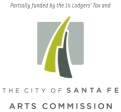






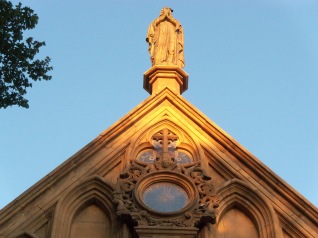

 Handel was born in Germany, musically trained in the music capitals of Italy, and spent most of his brilliant career in London. Initially he brought Italian opera to enthusiastic audiences in London. However, Italian opera was declining in England for a variety of reasons, including the “rising English annoyance with a form of entertainment in an unintelligible language sung by artists of whose morals they disapproved” (Britannica). As a consequence, Handel turned to creating oratorios, large-scale musical forms for solo voices, chorus, and orchestra, in the English language, without acting or scenery, and usually dramatizing a story from the Bible. Although based on sacred scripture, Handel’s oratorios were not church music for liturgical use, but “pious concerts” for public performance, meant to be at the same time edifying and entertaining.
Handel was born in Germany, musically trained in the music capitals of Italy, and spent most of his brilliant career in London. Initially he brought Italian opera to enthusiastic audiences in London. However, Italian opera was declining in England for a variety of reasons, including the “rising English annoyance with a form of entertainment in an unintelligible language sung by artists of whose morals they disapproved” (Britannica). As a consequence, Handel turned to creating oratorios, large-scale musical forms for solo voices, chorus, and orchestra, in the English language, without acting or scenery, and usually dramatizing a story from the Bible. Although based on sacred scripture, Handel’s oratorios were not church music for liturgical use, but “pious concerts” for public performance, meant to be at the same time edifying and entertaining.
 Known for her scintillating musicality and impeccable professionalism, Deborah’s career highlights thus far include leading roles with The Santa Fe Opera, Austin Lyric Opera, Michigan Opera Theater, New Orleans Opera, Opera Naples, Tulsa Opera, and St Petersburg Opera. Ms. Domanski’s solo concert performance engagements include The American Symphony Orchestra, Los Angeles Philharmonic, The Hong Kong Philharmonic, Utah Symphony, The Santa Fe Pro Musica Contemporary & Baroque Ensembles, The Asheville Symphony, and The Grand Rapids Bach Festival and her Weill Concert Hall debut as part of the Horne Foundation’s The Song Continues recital series at Carnegie Hall.
Known for her scintillating musicality and impeccable professionalism, Deborah’s career highlights thus far include leading roles with The Santa Fe Opera, Austin Lyric Opera, Michigan Opera Theater, New Orleans Opera, Opera Naples, Tulsa Opera, and St Petersburg Opera. Ms. Domanski’s solo concert performance engagements include The American Symphony Orchestra, Los Angeles Philharmonic, The Hong Kong Philharmonic, Utah Symphony, The Santa Fe Pro Musica Contemporary & Baroque Ensembles, The Asheville Symphony, and The Grand Rapids Bach Festival and her Weill Concert Hall debut as part of the Horne Foundation’s The Song Continues recital series at Carnegie Hall.



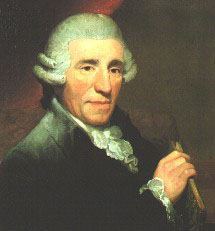 Haydn spent nearly 30 years (1761-1790) as Music Director for the wealthy Esterházy family at their remote estate in rural Hungary. Upon the death of his employer Prince Nikolaus in 1790, the successor, Prince Anton, who did not inherit his father’s pleasure in music, dismissed the resident orchestra. Haydn, however, remained Music Director with a full salary, but without any responsibilities. With income and freedom, Haydn accepted an offer from the impresario Johann Peter Salomon to compose and conduct an opera, six symphonies, and twenty other pieces during an extended stay in England. Haydn’s music was then especially fashionable in London and crowds flocked to see “the sight of that renowned composer. He so electrified the audience as to excite an attention and a pleasure superior to any that had ever been caused by instrumental music in England” (Charles Burney, 1726-1814).
Haydn spent nearly 30 years (1761-1790) as Music Director for the wealthy Esterházy family at their remote estate in rural Hungary. Upon the death of his employer Prince Nikolaus in 1790, the successor, Prince Anton, who did not inherit his father’s pleasure in music, dismissed the resident orchestra. Haydn, however, remained Music Director with a full salary, but without any responsibilities. With income and freedom, Haydn accepted an offer from the impresario Johann Peter Salomon to compose and conduct an opera, six symphonies, and twenty other pieces during an extended stay in England. Haydn’s music was then especially fashionable in London and crowds flocked to see “the sight of that renowned composer. He so electrified the audience as to excite an attention and a pleasure superior to any that had ever been caused by instrumental music in England” (Charles Burney, 1726-1814). A major musical figure of the 20th century and an accomplished pianist, Sergei Prokofiev tried to stay out of the tumultuous and stifling politics of the Soviet Union. He stated that, “in the Soviet Union music is addressed to millions of people who formerly had little or no contact with music. It is this new mass audience that the modern Soviet composer must strive to reach.” In conformity with this view, he produced works with clear formal structures, beautiful melodies, catchy rhythms and stunning orchestral color. In addition to its serious side, Prokofiev’s music is full of wit, humor and playfulness.
A major musical figure of the 20th century and an accomplished pianist, Sergei Prokofiev tried to stay out of the tumultuous and stifling politics of the Soviet Union. He stated that, “in the Soviet Union music is addressed to millions of people who formerly had little or no contact with music. It is this new mass audience that the modern Soviet composer must strive to reach.” In conformity with this view, he produced works with clear formal structures, beautiful melodies, catchy rhythms and stunning orchestral color. In addition to its serious side, Prokofiev’s music is full of wit, humor and playfulness. About Colin Jacobsen
About Colin Jacobsen


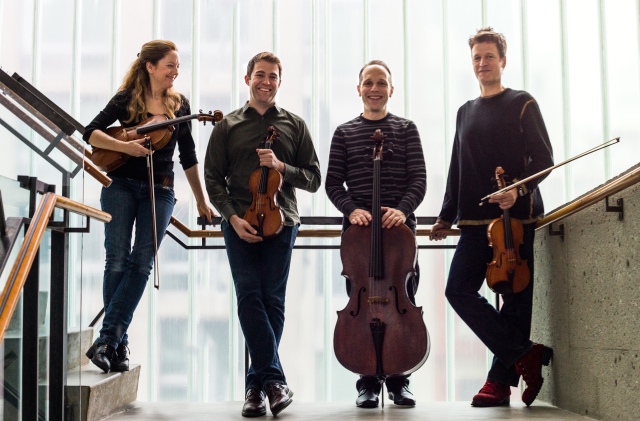 WHAT | St. Lawrence String Quartet
WHAT | St. Lawrence String Quartet
 Both of John Adams’ string quartets were composed for the St. Lawrence String Quartet. Speaking of their working relationship, Adams says, “String quartet writing is one of the most difficult challenges a composer can take on… the demands of handling this extremely volatile and transparent instrumental medium can easily be humbling, if not downright humiliating. What I appreciate about my friends in the St. Lawrence is their willingness to let me literally ‘improvise’ on them as if they were a piano or a drum and I a crazy man beating away with only the roughest outlines of what I want. They will go the distance with me, allow me to try and fail, and they will indulge my seizures of doubt, frustration and indecision, all the while providing intuitions and brilliant suggestions of their own…”
Both of John Adams’ string quartets were composed for the St. Lawrence String Quartet. Speaking of their working relationship, Adams says, “String quartet writing is one of the most difficult challenges a composer can take on… the demands of handling this extremely volatile and transparent instrumental medium can easily be humbling, if not downright humiliating. What I appreciate about my friends in the St. Lawrence is their willingness to let me literally ‘improvise’ on them as if they were a piano or a drum and I a crazy man beating away with only the roughest outlines of what I want. They will go the distance with me, allow me to try and fail, and they will indulge my seizures of doubt, frustration and indecision, all the while providing intuitions and brilliant suggestions of their own…”






 Edvard Grieg (1843-1907)
Edvard Grieg (1843-1907)



